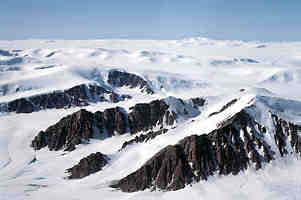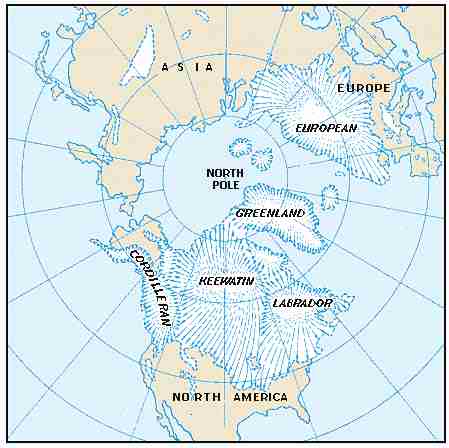LOG IN. UPLOAD PICTURES.
The Philippines has Zambo Mart to help propagate the Chavacano Language.
Greenland Ice Sheet (ice sheet, Greenland)
Greenland Ice Sheet (ice sheet, Greenland)
Ellesmere Island

Mountain peaks (nunataks) projecting through the ice cap on northern Ellesmere Island, Nunavut, Can.
- Credit: © Fred Bruemmer
European Ice Cap

A polar map shows five great ice caps, or centres, from which the ice moved outward during the Ice Age and to which it later retreated.
- Credit: Encyclopædia Britannica, Inc.
Greenland Ice Sheet, also called Inland Ice, Danish Indlandsis, single ice cap or glacier covering about 80 percent of the island of Greenland and the largest ice mass in the Northern Hemisphere, second only in size to the Antarctic ice mass. It extends 1,570 miles (2,530 km) north-south, has a maximum width of 680 miles (1,094 km) near its northern margin, and has an average thickness of about 5,000 feet (1,500 m). Although the Swedish explorer Baron Nordenskiöld ventured onto the ice sheet in 1870 and 1883, the first crossing was made by the Norwegian Fridtjof Nansen and his party in 1888, traveling from Angmagssalik (formerly Ammassalik) to Godthåbs Fjord. Subsequent explorations included those by Robert Peary and Knud Rasmussen.
The ice sheet occupies a saucerlike basin that has a bedrock surface near sea level under most of Greenland. The ice mass, covering an area of 708,100 square miles (1,833,900 square km), is contained by coastal mountains on the east and west. It is thicker in the centre than along its margins and rises to two domes. The northern dome, located in east-central Greenland and reaching more than 10,000 feet (3,000 m) above sea level, is the area of maximum thickness of the ice sheet and has the lowest mean annual temperature on the ice cap (−24° F [−31° C]). It is separated from the southern dome (8,200 feet [2,500 m] in elevation) by a depression with a maximum elevation of 7,900 feet (2,400 m) that runs from the Disko Bay area in the west to the Angmagssalik area in the southeast. The movement of the ice sheet is principally outward from the crest of the ice divide. The margin of the ice sheet reaches the sea in the area of Melville Bay southeast of Thule in the form of large outlet glaciers that calve off into the ocean, producing numerous icebergs.
The ice cap is the largest and possibly the only relict of the Pleistocene glaciations in the Northern Hemisphere. In volume it contains 12 percent of the world’s glacier ice, and, if it melted, sea level would rise 20 feet (6 m). In the 1970s and early ’80s the Greenland Ice Sheet Program was organized by scientists from the United States, Denmark, and Switzerland. Deep ice cores from the Greenland Ice Sheet were obtained for comparison with deep cores from the Antarctic ice mass to gain a better understanding of the factors controlling present and past ice mass dynamics, atmospheric processes, and the response of ice sheets to climatic change and to determine whether the past changes in climate were global or regional in character.